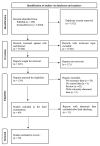Does Lead Have a Connection to Autism? A Systematic Review and Meta-Analysis
- PMID: 37755763
- PMCID: PMC10536388
- DOI: 10.3390/toxics11090753
Does Lead Have a Connection to Autism? A Systematic Review and Meta-Analysis
Abstract
Environmental pollutants, particularly toxic trace metals with neurotoxic potential, have been related to the genesis of autism. One of these metals that stands out, in particular, is lead (Pb). We conducted an in-depth systematic review and meta-analysis of peer-reviewed studies on Pb levels in biological materials retrieved from autistic children (cases) and neurotypical children (controls) in this work. A systematic review was conducted after the careful selection of published studies according to established criteria to gain a broad insight into the higher or lower levels of Pb in the biological materials of cases and controls, and the findings were then strengthened by a meta-analysis. The meta-analysis included 17 studies (hair), 13 studies (whole blood), and 8 studies (urine). The overall number of controls/cases was 869/915 (hair), 670/755 (whole blood), and 344/373 (urine). This meta-analysis showed significantly higher Pb levels in all three types of biological material in cases than in controls, suggesting a higher body Pb burden in autistic children. Thus, environmental Pb exposure could be related to the genesis of autism. Since no level of Pb can be considered safe, the data from this study undoubtedly point to the importance of regularly monitoring Pb levels in autistic children.
Keywords: autism; biological material; lead; meta-analysis; systematic review.
Conflict of interest statement
The authors declare no conflict of interest.
Figures







Similar articles
-
Heavy metals and trace elements in hair and urine of a sample of arab children with autistic spectrum disorder.Maedica (Bucur). 2011 Oct;6(4):247-57. Maedica (Bucur). 2011. PMID: 22879836 Free PMC article.
-
Exposure to Inorganic Arsenic and Lead and Autism Spectrum Disorder in Children: A Systematic Review and Meta-Analysis.Chem Res Toxicol. 2019 Oct 21;32(10):1904-1919. doi: 10.1021/acs.chemrestox.9b00134. Epub 2019 Oct 4. Chem Res Toxicol. 2019. PMID: 31549506
-
Level of trace elements (copper, zinc, magnesium and selenium) and toxic elements (lead and mercury) in the hair and nail of children with autism.Biol Trace Elem Res. 2011 Aug;142(2):148-58. doi: 10.1007/s12011-010-8766-2. Epub 2010 Jul 13. Biol Trace Elem Res. 2011. PMID: 20625937
-
Association between heavy metals exposure (cadmium, lead, arsenic, mercury) and child autistic disorder: a systematic review and meta-analysis.Front Pediatr. 2023 Jul 4;11:1169733. doi: 10.3389/fped.2023.1169733. eCollection 2023. Front Pediatr. 2023. PMID: 37469682 Free PMC article.
-
Association of autism with toxic metals: A systematic review of case-control studies.Pharmacol Biochem Behav. 2022 Jan;212:173313. doi: 10.1016/j.pbb.2021.173313. Epub 2021 Dec 9. Pharmacol Biochem Behav. 2022. PMID: 34896416
Cited by
-
Urine manganese, cadmium, lead, arsenic, and selenium among autism spectrum disorder children in Kuala Lumpur.PeerJ. 2024 Jul 4;12:e17660. doi: 10.7717/peerj.17660. eCollection 2024. PeerJ. 2024. PMID: 38974411 Free PMC article.
-
An ecological study shows increased prevalence of autism spectrum disorder in children living in a heavily polluted area.Sci Rep. 2024 Jul 26;14(1):17159. doi: 10.1038/s41598-024-67980-0. Sci Rep. 2024. PMID: 39060326 Free PMC article.
-
Lead contamination in human milk affects infants' language trajectory: results from a prospective cohort study.Front Public Health. 2024 Aug 13;12:1450570. doi: 10.3389/fpubh.2024.1450570. eCollection 2024. Front Public Health. 2024. PMID: 39193201 Free PMC article.
-
Environmental pollutants as risk factors for autism spectrum disorders: a systematic review and meta-analysis of cohort studies.BMC Public Health. 2024 Sep 3;24(1):2388. doi: 10.1186/s12889-024-19742-w. BMC Public Health. 2024. PMID: 39223561 Free PMC article.
-
Hippocampal Proteomics Reveals the Novel Molecular Profiling of Postnatal Lead (Pb) Exposure on Autism-like Behaviors.Toxics. 2025 May 31;13(6):465. doi: 10.3390/toxics13060465. Toxics. 2025. PMID: 40559938 Free PMC article.
References
-
- WHO World Health Organization. 2023. [(accessed on 15 May 2023)]. Available online: https://www.who.int/news-room/fact-sheets/detail/autism-spectrum-disorde....
Publication types
LinkOut - more resources
Full Text Sources

